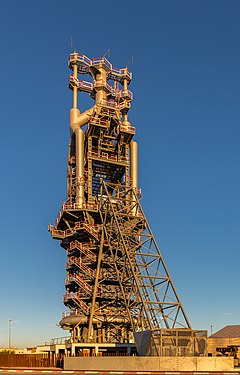
Back Hoogoond Afrikaans فرن لافح Arabic Доменная печ Byelorussian Доменна пещ Bulgarian মারুত চুল্লি Bengali/Bangla Visoka peć BS Alt forn Catalan Vysoká pec Czech Ffwrnais chwyth Welsh Højovn Danish

A blast furnace is a type of metallurgical furnace used for smelting to produce industrial metals, generally pig iron, but also others such as lead or copper. Blast refers to the combustion air being supplied above atmospheric pressure.[1]
In a blast furnace, fuel (coke), ores, and flux (limestone) are continuously supplied through the top of the furnace, while a hot blast of air (sometimes with oxygen enrichment) is blown into the lower section of the furnace through a series of pipes called tuyeres, so that the chemical reactions take place throughout the furnace as the material falls downward. The end products are usually molten metal and slag phases tapped from the bottom, and waste gases (flue gas) exiting from the top of the furnace.[2] The downward flow of the ore along with the flux in contact with an upflow of hot, carbon monoxide-rich combustion gases is a countercurrent exchange and chemical reaction process.[3]
In contrast, air furnaces (such as reverberatory furnaces) are naturally aspirated, usually by the convection of hot gases in a chimney flue. According to this broad definition, bloomeries for iron, blowing houses for tin, and smelt mills for lead would be classified as blast furnaces. However, the term has usually been limited to those used for smelting iron ore to produce pig iron, an intermediate material used in the production of commercial iron and steel, and the shaft furnaces used in combination with sinter plants in base metals smelting.[4][5]
Blast furnaces are estimated to have been responsible for over 4% of global greenhouse gas emissions between 1900 and 2015, but are difficult to decarbonize.[6]
- ^ "Blast furnace | Definition, Temperature, Diagrams, & Facts | Britannica". www.britannica.com. 11 October 2024. Retrieved 8 November 2024.
- ^ Schmult, Brian (2016). "Evolution of the Hopewell Furnace Blast Machinery". IA. The Journal of the Society for Industrial Archeology. 42 (2): 5–22.
- ^ Spirin, N A; Yaroshenko, Yu G; Lavrov, V V (September 2016). "Development of heat-transfer circuits in the blast furnace". IOP Conference Series: Materials Science and Engineering. 150 (1): 012022. Bibcode:2016MS&E..150a2022S. doi:10.1088/1757-899X/150/1/012022.
- ^ P J Wand, "Copper smelting at Electrolytic Refining and Smelting Company of Australia Ltd., Port Kembla, N.S.W.", in: Mining and Metallurgical Practices in Australasia: The Sir Maurice Mawby Memorial Volume, Ed J T Woodcock (The Australasian Institute of Mining and Metallurgy: Melbourne, 1980) 335–340.
- ^ R J Sinclair, The Extractive Metallurgy of Lead (The Australasian Institute of Mining and Metallurgy: Melbourne, 2009), 9–12.
- ^ Pooler, Michael (January 2019). "Cleaning up steel is key to tackling climate change". Financial Times. Archived from the original on 10 December 2022. Retrieved 7 July 2021.